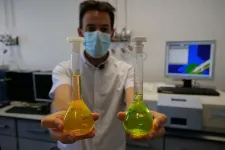(Press-News.org) While the IPCC is in the midst of the drafting cycle of the Sixth Assessment Report, whose publication will start in the second half of 2021 - one of the most relevant events for the global climate change community, there is an ongoing debate on how to assess the feasibility of ambitious climate mitigation scenarios developed through integrated assessment models and to what extent they are actually achievable in the real world. In their new study published in Environmental Research Letters, researchers from the RFF-CMCC European Institute on Economics and the Environment (EIEE) and IIASA developed a systematic framework that allows identifying the type, timing, and location of feasibility concerns raised by climate mitigation scenarios.
Feasibility is a complex concept that is currently getting significant academic attention. The authors build on the past advancements in theoretical discussions and propose to operationalize feasibility in terms of timing, disruptiveness and scale of transformation across geophysical, technological, economic, institutional and socio-cultural feasibility dimensions. A feasibility evaluation of each indicator in each decade is developed, and a flexible aggregation procedure allows assessing feasibility concerns across dimensions and time. This flexible approach allows looking at the "big picture", to assess for instance which dimension raises major feasibility concerns, but also analyzing more detailed questions such as intertemporal trade-offs within and across different dimensions.
This systematic framework is extremely useful to understand what to improve in the next generation of scenarios but also to analyze more systematically what type of enabling factors might bring us closer to more ambitious mitigation paths.
The paper just published applies the framework to the publicly available scenario set from the IPCC Special Report on Global Warming of 1.5°C. "One of our major findings is that currently many scenarios assume relatively fast overall decarbonization rate in regions which have a relatively low mitigation capacity", says Elina Brutschin, a Research Scholar at IIASA within the Transformative Institutional and Social Solutions Research Group, and first author of the study. "This suggests that many feasibility concerns are related to institutional constraints such as government effectiveness". While improving the quality of governance in many regions might be complicated, targeted capacity building and investments can significantly contribute to overcoming this challenge.
"Currently, to assess socio-cultural feasibility concerns, we focus on the transformation that is manifested through behavioral changes in diets and energy consumption. It is a research branch that shows great potential and opens up a lot of critical work to achieve more and more detailed results. In the future we plan to improve our evaluation of socio-cultural feasibility concerns by including more indicators and incorporating insights on attitudes and behavioral changes from the social sciences", says Silvia Pianta, a Postdoctoral Researcher EIEE and PhD Fellow at Bocconi University. "Here we find that the current generation of scenarios does not explore demand-side mitigation to its full potential and that more research is necessary in this area", adds Bas van Ruijven, who is the leader of the Sustainable Service Systems (S3) group in the Energy, Climate, and Environment (ECE) program at IIASA.
Massimo Tavoni, Director of EIEE and Professor of Climate Change Economics at Politecnico di Milano, highlights that the framework allows tracing important intertemporal trade-offs. "As argued in past studies focusing on mitigation costs, we now clearly show that delaying global climate action increases feasibility risks, because delayed action requires an overall larger system to be transformed much faster and by relying on new technologies". Valentina Bosetti, Senior Scientist at EIEE and Professor at the Economics Department of Bocconi University, adds that "a better understanding of inter-temporal and inter-dimensional trade-offs, incorporating insights from experts and policymakers, is essential to take the feasibility concepts to the next level".
As part of this framework, an interactive visual tool was developed with the key contribution of Giacomo Marangoni, Researcher at EIEE and Assistant Professor at Politecnico di Milano, who points out that "a new data visualization method is extremely valuable when looking at multidimensional concepts such as feasibility. We developed a tool that allows visualizing our feasibility evaluations for different scenarios and assessing the sensitivity of our results to the definition of different feasibility concern thresholds".
Finally, Keywan Riahi, who is the Director of the Energy, Climate, and Environment Program at IIASA, summarizes that "a new versatile framework was developed that can be applied to any set of scenarios and constantly improved by incorporating new insights from the empirical literature on what is feasible in the real world". He also adds that "while currently the framework was developed to evaluate global scenarios, it can be adjusted to have a more systematic evaluation of regional or national feasibility concerns".
INFORMATION:
Reference:
Brutschin, E., Pianta, S., Tavoni, M., Riahi, K., Bosetti, V., Marangoni, G., and van Ruijven, B. (2021) A multidimensional feasibility evaluation of low-carbon scenarios. Environmental Research Letters.
https://doi.org/10.1088/1748-9326/abf0ce
About: RFF-CMCC European Institute on Economics and the Environment (EIEE)
RFF-CMCC European Institute on Economics and the Environment leverages two leading international centers for economic and environmental research: RFF - Resources for the Future and CMCC - Euro-Mediterranean Center on Climate Change. EIEE's research aims to improve environmental, energy, and natural resource decisions through impartial economic research and policy engagement to facilitate the transition to a sustainable, inclusive society. The focus is on issues surrounding but not limited to climate change, including a wide range of environmental, energy, natural resource, and societal issues.
About IIASA:
The International Institute for Applied Systems Analysis (IIASA) is an international scientific institute that conducts research into the critical issues of global environmental, economic, technological, and social change that we face in the twenty-first century. Our findings provide valuable options to policymakers to shape the future of our changing world. IIASA is independent and funded by prestigious research funding agencies in Africa, the Americas, Asia, and Europe. http://www.iiasa.ac.at
What The Study Did: An observational study of more than 27,000 veterans who received a positive test result for COVID-19 reports that risk factors such as housing problems, financial hardship, alcohol use, tobacco use and substance use weren't associated with higher mortality.
Authors: J. Daniel Kelly, M.D., M.P.H., of the University of California, San Francisco, is the corresponding author.
To access the embargoed study: Visit our For The Media website at this link https://media.jamanetwork.com/
(doi:10.1001/jamanetworkopen.2021.13031)
Editor's Note: The article includes funding/support disclosures. Please ...
What The Study Did: This study looked at whether there was an association between rideshare use, motor vehicle crash traumas and impaired driving convictions in Houston, Texas, by comparing traumas and convictions before and after the introduction of Uber.
Authors: Christopher R. Conner, M.D., Ph.D., of the McGovern Medical School at the University of Texas Health Science Center at Houston, is the corresponding author.
To access the embargoed study: Visit our For The Media website at this link https://media.jamanetwork.com/
(doi:10.1001/jamasurg.2021.2227)
Editor's Note: The article includes funding/support disclosures. Please see the article for additional information, including other authors, ...
A condition that affects the blood, known as idiopathic thrombocytopenic purpura (ITP), may be associated the Oxford-AstraZeneca vaccine in rare cases, research suggests.
The very small increased risk of the condition - which is characterised by low platelet counts - is estimated to be 11 per million doses, similar to figures seen in vaccines for flu and MMR.
A low number of platelets - blood cells that help prevent blood loss when vessels are damaged - can result in no symptoms or can lead to an increased risk of bleeding or, in some cases, clotting.
Researchers say that the increased chance of developing ITP after receiving the vaccine remains smaller than the risk of developing it because of Covid-19 and should ...
Batteries have come a long way since Volta first stacked copper and zinc discs together 200 years ago. While the technology has continued to evolve from lead-acid to lithium-ion, many challenges still exist--like achieving higher density and suppressing dendrite growth. Experts are racing to address the growing, global need for energy-efficient and safe batteries.
The electrification of heavy-duty vehicles and aircraft requires batteries with more energy density. A team of researchers believes a paradigm shift is necessary to make a significant impact in battery technology for these industries. ...
Scientists from the lab of Franz Klein from the Department of Chromosome Biology at the Max Perutz Labs, a joint venture of the University of Vienna and the Medical University of Vienna, have now discovered that cells sometimes liberate DNA fragments at sites of paired, or double, DSBs. Whilst this presents an obvious risk of germline mutations as a consequence of erroneous repair or of integration of fragments from elsewhere at break sites, it may also be a source of evolutionary diversity. The study is published as a research article in Nature.
Genetic information in humans is encoded in 23 chromosome pairs, where one pair consists of two slightly different copies or homologs. One is inherited from the father and one from the mother. Human gametes, however, are haploid - they start ...
Researchers at the University of Geneva (UNIGE) demonstrate that innovative projects spearheaded by United Nations (UN) country offices are remodeling the institution and expanding its role. Digital initiatives, particularly those scaled through headquarters, were shown to have the strongest impact, changing ways of working, embedding new skills, and restructuring teams across the UN. These findings, published in the Journal of Management Studies, highlight that fostering even single innovative projects could lead to fundamental transformations in the UN.
How do International Organizations build innovation capabilities ...
Scientists from the University of Melbourne and University of Queensland have revealed the mystery behind the unique reproductive parts of the much-loved echidna.
In the paper, "The Unique Penile Morphology of the Short-Beaked Echidna, Tachyglossus aculeatus", the team detail how the male monotreme's testes never descend, have no scrotum, and when not in use, their penis is stored internally.
They also detail how the echidna penis has four heads, which are actually rosette-like glans at the end. Just two of the four glans ever become functional during erection ...
Led by Professor Andreas Hartmann, from the University of Freiburg (Germany), the researchers analyzed the presence of several pollutants in water from many karst aquifers of Europe, North Africa, and the Middle East, relating fast infiltration processes to an increased concentration of these substances. The findings of this research are published in the scientific journal Proceedings of the National Academy of Sciences (PNAS).
This way, they warn that during rainfall events -when aquifers recharge, especially during autumn rainfall- the concentration of pollutants and pathogenic microorganisms can significantly exceed the safe levels, causing serious consequences for human consumption.
"About one quarter of the ...
Obesity is generally linked to poor eating habits and the availability of tasty, high-calorie foods. However, a new study led by researchers from the Magnetic Resonance Imaging Research Unit in the Department of Radiology at Hospital del Mar and the Barcelona Institute for Global Health (ISGlobal), a centre supported by the "la Caixa" Foundation, has found that more elements are involved. Thanks to images obtained by functional magnetic resonance imaging, the researchers found that certain parts of the brains of obese children show alterations with respect to normal-weight or overweight children of the same age. ...
At the heart of almost every sufficiently massive galaxy there is a black hole whose gravitational field, although very intense, affects only a small region around the centre of the galaxy. Even though these objects are thousands of millions of times smaller than their host galaxies our current view is that the Universe can be understood only if the evolution of galaxies is regulated by the activity of these black holes, because without them the observed properties of the galaxies cannot be explained.
Theoretical predictions suggest that as these black holes grow they generate sufficient energy to heat ...




